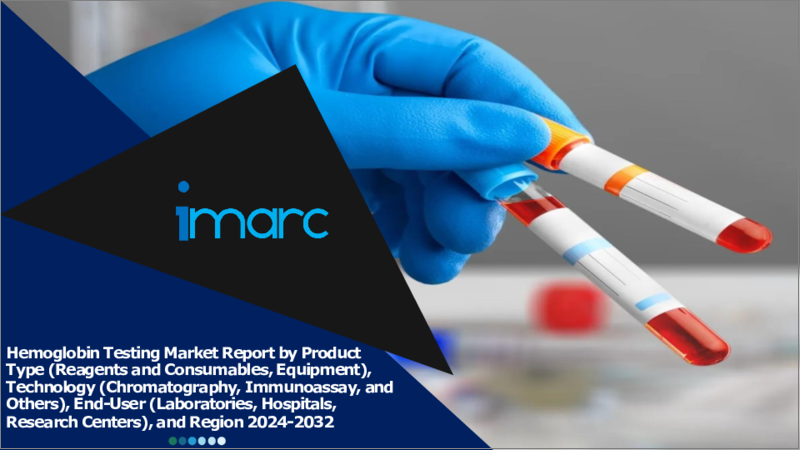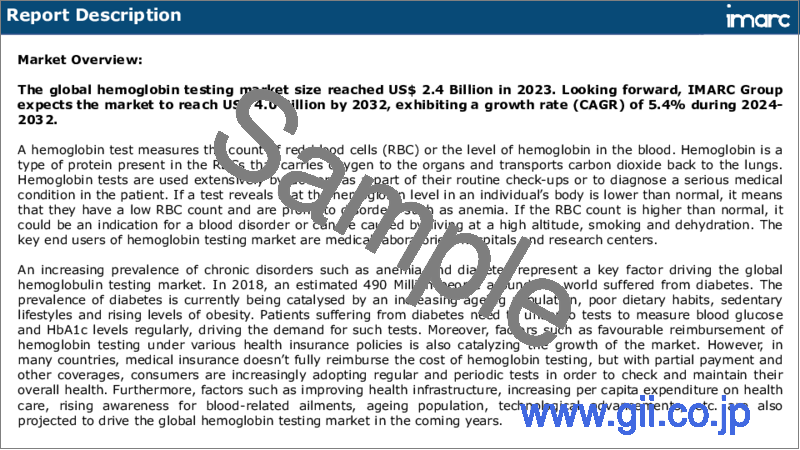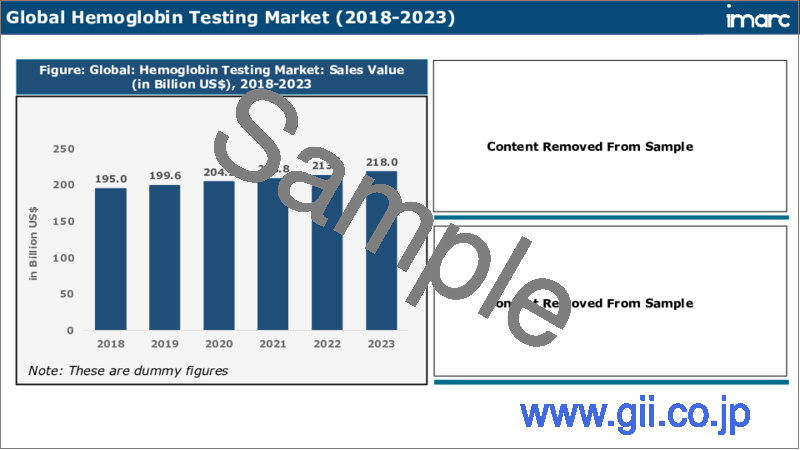|
|
市場調査レポート
商品コード
1561655
ヘモグロビン検査市場レポート:製品タイプ、技術、エンドユーザー、地域別、2024年~2032年Hemoglobin Testing Market Report by Product Type (Reagents and Consumables, Equipment), Technology (Chromatography, Immunoassay, and Others), End-User (Laboratories, Hospitals, Research Centers), and Region 2024-2032 |
||||||
カスタマイズ可能
|
|||||||
| ヘモグロビン検査市場レポート:製品タイプ、技術、エンドユーザー、地域別、2024年~2032年 |
|
出版日: 2024年09月10日
発行: IMARC
ページ情報: 英文 138 Pages
納期: 2~3営業日
|
- 全表示
- 概要
- 図表
- 目次
世界のヘモグロビン検査市場の市場規模は2023年に24億米ドルに達しました。今後、IMARC Groupは、市場は2032年までに40億米ドルに達し、2024年から2032年の間に5.4%の成長率(CAGR)を示すと予測しています。
ヘモグロビン検査は、血液中の赤血球(RBC)数またはヘモグロビン濃度を測定します。ヘモグロビンは赤血球中に存在するタンパク質の一種で、酸素を臓器に運び、二酸化炭素を肺に戻します。ヘモグロビン検査は、医師が定期検診の一環として、あるいは患者の重篤な病状を診断するために、広く行われています。検査によって体内のヘモグロビン濃度が正常値より低いことが判明した場合、その人は赤血球数が少なく、貧血などの障害を起こしやすいことを意味します。赤血球数が正常値より高い場合は、血液疾患の兆候であるか、高地での生活、喫煙、脱水が原因である可能性があります。ヘモグロビン検査の主なエンドユーザーは、医学研究所、病院、研究センターです。
貧血や糖尿病などの慢性疾患の有病率の増加は、世界のヘモグロブリン検査市場を牽引する主要因です。2018年には、世界中で推定4億9,000万人が糖尿病に苦しんでいます。糖尿病の流行は現在、高齢化人口の増加、食生活の乱れ、座りっぱなしのライフスタイル、肥満レベルの上昇によって引き起こされています。糖尿病を患う患者は、定期的に血糖値やHbA1c値を測定する検査を受ける必要があり、このような検査の需要を牽引しています。さらに、さまざまな医療保険政策の下でのヘモグロビン検査の有利な償還などの要因も、市場の成長を触媒しています。しかし、多くの国では、医療保険がヘモグロビン検査の費用を完全に払い戻すわけではなく、部分的な支払いやその他の保障によって、消費者は全身の健康をチェックし維持するために定期的・周期的な検査を採用するようになってきています。さらに、医療インフラの改善、医療に対する一人当たり支出の増加、血液関連疾患に対する意識の高まり、高齢化、技術の進歩などの要因も、今後数年間の世界のヘモグロビン検査市場を牽引すると予測されます。
本レポートで扱う主な質問
- ヘモグロビン検査市場の世界市場はこれまでどのように推移してきたか?
- 世界のヘモグロビン検査業界の主要地域市場は?
- COVID-19が世界のヘモグロビン検査業界に与えた影響は?
- 製品タイプ別の市場内訳は?
- 技術別の市場内訳は?
- エンドユーザー別の市場内訳は?
- 世界のヘモグロビン検査産業のバリューチェーンにおける様々な段階とは?
- 世界のヘモグロビン検査産業の主要な促進要因と課題は何か?
- 世界のヘモグロビン検査産業の構造と主要プレーヤーは?
- 世界のヘモグロビン検査業界における競合の程度は?
- 世界のヘモグロビン検査業界の利益率は?
目次
第1章 序文
第2章 調査範囲と調査手法
- 調査の目的
- ステークホルダー
- データソース
- 一次情報
- 二次情報
- 市場推定
- ボトムアップアプローチ
- トップダウンアプローチ
- 調査手法
第3章 エグゼクティブサマリー
第4章 イントロダクション
- 概要
- 主要業界動向
第5章 世界のヘモグロビン検査市場
- 市場概要
- 市場実績
- COVID-19の影響
- 市場内訳:製品タイプ別
- 市場内訳:技術別
- 市場内訳:エンドユーザー別
- 市場内訳:地域別
- 市場予測
第6章 市場内訳:製品タイプ別
- 試薬および消耗品
- 市場動向
- 市場予測
- 装置
- 市場動向
- 市場予測
第7章 市場内訳:技術別
- クロマトグラフィー
- 市場動向
- 市場予測
- 免疫測定
- 市場動向
- 市場予測
- その他
- 市場動向
- 市場予測
第8章 市場内訳:エンドユーザー別
- 研究所
- 市場動向
- 市場予測
- 病院
- 市場動向
- 市場予測
- 研究センター
- 市場動向
- 市場予測
第9章 市場内訳:地域別
- 欧州
- 市場動向
- 市場予測
- 北米
- 市場動向
- 市場予測
- アジア太平洋
- 市場動向
- 市場予測
- 中東・アフリカ
- 市場動向
- 市場予測
- ラテンアメリカ
- 市場動向
- 市場予測
第10章 SWOT分析
- 概要
- 強み
- 弱み
- 機会
- 脅威
第11章 バリューチェーン分析
第12章 ポーターのファイブフォース分析
- 概要
- 買い手の交渉力
- 供給企業の交渉力
- 競合の程度
- 新規参入業者の脅威
- 代替品の脅威
第13章 価格分析
第14章 競合情勢
- 市場構造
- 主要企業
- 主要企業のプロファイル
- Abbott Laboratories
- Bio-Rad Laboratories
- Danaher
- EKF Diagnostics
- F. Hoffmann-La Roche
- Siemens Healthineers
- Thermo Fisher Scientific
- Alere
- ACON Laboratories
- ARKRAY
- Bayer Medical Care
- Daiichi Biotech
- DiaSys Diagnostic Systems
- Epinex Diagnostics
- Erba Diagnostics
List of Figures
- Figure 1: Global: Hemoglobin Testing Market: Major Drivers and Challenges
- Figure 2: Global: Hemoglobin Testing Market: Sales Value (in Billion US$), 2018-2023
- Figure 3: Global: Hemoglobin Testing Market: Breakup by Product Type (in %), 2023
- Figure 4: Global: Hemoglobin Testing Market: Breakup by Technology (in %), 2023
- Figure 5: Global: Hemoglobin Testing Market: Breakup by End-User (in %), 2023
- Figure 6: Global: Hemoglobin Testing Market: Breakup by Region (in %), 2023
- Figure 7: Global: Hemoglobin Testing Market Forecast: Sales Value (in Billion US$), 2024-2032
- Figure 8: Global: Hemoglobin Testing Industry: SWOT Analysis
- Figure 9: Global: Hemoglobin Testing Industry: Value Chain Analysis
- Figure 10: Global: Hemoglobin Testing Industry: Porter's Five Forces Analysis
- Figure 11: Global: Hemoglobin Testing (Reagents and Consumables) Market: Sales Value (in Million US$), 2018 & 2023
- Figure 12: Global: Hemoglobin Testing (Reagents and Consumables) Market Forecast: Sales Value (in Million US$), 2024-2032
- Figure 13: Global: Hemoglobin Testing (Equipment) Market: Sales Value (in Million US$), 2018 & 2023
- Figure 14: Global: Hemoglobin Testing (Equipment) Market Forecast: Sales Value (in Million US$), 2024-2032
- Figure 15: Global: Hemoglobin Testing (Chromatography) Market: Sales Value (in Million US$), 2018 & 2023
- Figure 16: Global: Hemoglobin Testing (Chromatography) Market Forecast: Sales Value (in Million US$), 2024-2032
- Figure 17: Global: Hemoglobin Testing (Immunoassay) Market: Sales Value (in Million US$), 2018 & 2023
- Figure 18: Global: Hemoglobin Testing (Immunoassay) Market Forecast: Sales Value (in Million US$), 2024-2032
- Figure 19: Global: Hemoglobin Testing (Others) Market: Sales Value (in Million US$), 2018 & 2023
- Figure 20: Global: Hemoglobin Testing (Others) Market Forecast: Sales Value (in Million US$), 2024-2032
- Figure 21: Global: Hemoglobin Testing (Laboratories) Market: Sales Value (in Million US$), 2018 & 2023
- Figure 22: Global: Hemoglobin Testing (Laboratories) Market Forecast: Sales Value (in Million US$), 2024-2032
- Figure 23: Global: Hemoglobin Testing (Hospitals) Market: Sales Value (in Million US$), 2018 & 2023
- Figure 24: Global: Hemoglobin Testing (Hospitals) Market Forecast: Sales Value (in Million US$), 2024-2032
- Figure 25: Global: Hemoglobin Testing (Research Centers) Market: Sales Value (in Million US$), 2018 & 2023
- Figure 26: Global: Hemoglobin Testing (Research Centers) Market Forecast: Sales Value (in Million US$), 2024-2032
- Figure 27: Europe: Hemoglobin Testing Market: Sales Value (in Million US$), 2018 & 2023
- Figure 28: Europe: Hemoglobin Testing Market Forecast: Sales Value (in Million US$), 2024-2032
- Figure 29: North America: Hemoglobin Testing Market: Sales Value (in Million US$), 2018 & 2023
- Figure 30: North America: Hemoglobin Testing Market Forecast: Sales Value (in Million US$), 2024-2032
- Figure 31: Asia Pacific: Hemoglobin Testing Market: Sales Value (in Million US$), 2018 & 2023
- Figure 32: Asia Pacific: Hemoglobin Testing Market Forecast: Sales Value (in Million US$), 2024-2032
- Figure 33: Middle East and Africa: Hemoglobin Testing Market: Sales Value (in Million US$), 2018 & 2023
- Figure 34: Middle East and Africa: Hemoglobin Testing Market Forecast: Sales Value (in Million US$), 2024-2032
- Figure 35: Latin America: Hemoglobin Testing Market: Sales Value (in Million US$), 2018 & 2023
- Figure 36: Latin America: Hemoglobin Testing Market Forecast: Sales Value (in Million US$), 2024-2032
List of Tables
- Table 1: Global: Hemoglobin Testing Market: Key Industry Highlights, 2023 and 2032
- Table 2: Global: Hemoglobin Testing Market Forecast: Breakup by Product Type (in Million US$), 2024-2032
- Table 3: Global: Hemoglobin Testing Market Forecast: Breakup by End-User (in Million US$), 2024-2032
- Table 4: Global: Hemoglobin Testing Market Forecast: Breakup by Technology (in Million US$), 2024-2032
- Table 5: Global: Hemoglobin Testing Market Forecast: Breakup by Region (in Million US$), 2024-2032
- Table 6: Global: Hemoglobin Testing Market Structure
- Table 7: Global: Hemoglobin Testing Market: Key Players
The global hemoglobin testing market size reached US$ 2.4 Billion in 2023. Looking forward, IMARC Group expects the market to reach US$ 4.0 Billion by 2032, exhibiting a growth rate (CAGR) of 5.4% during 2024-2032.
A hemoglobin test measures the count of red blood cells (RBC) or the level of hemoglobin in the blood. Hemoglobin is a type of protein present in the RBCs that carries oxygen to the organs and transports carbon dioxide back to the lungs. Hemoglobin tests are used extensively by doctors as a part of their routine check-ups or to diagnose a serious medical condition in the patient. If a test reveals that the hemoglobin level in an individual's body is lower than normal, it means that they have a low RBC count and are prone to disorders such as anemia. If the RBC count is higher than normal, it could be an indication for a blood disorder or can be caused by living at a high altitude, smoking and dehydration. The key end users of hemoglobin testing market are medical laboratories, hospitals and research centers.
An increasing prevalence of chronic disorders such as anemia and diabetes represent a key factor driving the global hemoglobulin testing market. In 2018, an estimated 490 Million people around the world suffered from diabetes. The prevalence of diabetes is currently being catalysed by an increasing ageing population, poor dietary habits, sedentary lifestyles and rising levels of obesity. Patients suffering from diabetes need to undergo tests to measure blood glucose and HbA1c levels regularly, driving the demand for such tests. Moreover, factors such as favourable reimbursement of hemoglobin testing under various health insurance policies is also catalyzing the growth of the market. However, in many countries, medical insurance doesn't fully reimburse the cost of hemoglobin testing, but with partial payment and other coverages, consumers are increasingly adopting regular and periodic tests in order to check and maintain their overall health. Furthermore, factors such as improving health infrastructure, increasing per capita expenditure on health care, rising awareness for blood-related ailments, ageing population, technological advancements, etc. are also projected to drive the global hemoglobin testing market in the coming years.
Key Market Segmentation:
IMARC Group provides an analysis of the key trends in each sub-segment of the global hemoglobin testing market report, along with forecasts at the global and regional level from 2024-2032. Our report has categorized the market based on product type, technology, and end-user.
Breakup by Product Type:
- Reagents and Consumables
- Equipment
Breakup by Technology:
- Chromatography
- Immunoassay
- Others
Breakup by End-User:
- Laboratories
- Hospitals
- Research Centers
Breakup by Region:
- North America
- Europe
- Asia Pacific
- Middle East and Africa
- Latin America
Competitive Landscape:
The report has also analysed the competitive landscape of the market with some of the key players being Abbott Laboratories, Bio-Rad Laboratories, Danaher, EKF Diagnostics, F. Hoffmann-La Roche, Siemens Healthineers, Thermo Fisher Scientific, Alere, ACON Laboratories, ARKRAY, Bayer Medical Care, Daiichi Biotech, DiaSys Diagnostic Systems, Epinex Diagnostics, Erba Diagnostics, etc.
Key Questions Answered in This Report:
- How has the global hemoglobin testing market performed so far and how will it perform in the coming years?
- What are the key regional markets in the global hemoglobin testing industry?
- What has been the impact of COVID-19 on the global hemoglobin testing industry?
- What is the breakup of the market based on the product type?
- What is the breakup of the market based on the technology?
- What is the breakup of the market based on the end-user?
- What are the various stages in the value chain of the global hemoglobin testing industry?
- What are the key driving factors and challenges in the global hemoglobin testing industry?
- What is the structure of the global hemoglobin testing industry and who are the key players?
- What is the degree of competition in the global hemoglobin testing industry?
- What are the profit margins in the global hemoglobin testing industry?
Table of Contents
1 Preface
2 Scope and Methodology
- 2.1 Objectives of the Study
- 2.2 Stakeholders
- 2.3 Data Sources
- 2.3.1 Primary Sources
- 2.3.2 Secondary Sources
- 2.4 Market Estimation
- 2.4.1 Bottom-Up Approach
- 2.4.2 Top-Down Approach
- 2.5 Forecasting Methodology
3 Executive Summary
4 Introduction
- 4.1 Overview
- 4.2 Key Industry Trends
5 Global Hemoglobin Testing Market
- 5.1 Market Overview
- 5.2 Market Performance
- 5.3 Impact of COVID-19
- 5.4 Market Breakup by Product Type
- 5.5 Market Breakup by Technology
- 5.6 Market Breakup by End-User
- 5.7 Market Breakup by Region
- 5.8 Market Forecast
6 Market Breakup by Product Type
- 6.1 Reagents and Consumables
- 6.1.1 Market Trends
- 6.1.2 Market Forecast
- 6.2 Equipment
- 6.2.1 Market Trends
- 6.2.2 Market Forecast
7 Market Breakup by Technology
- 7.1 Chromatography
- 7.1.1 Market Trends
- 7.1.2 Market Forecast
- 7.2 Immunoassay
- 7.2.1 Market Trends
- 7.2.2 Market Forecast
- 7.3 Others
- 7.3.1 Market Trends
- 7.3.2 Market Forecast
8 Market Breakup by End-User
- 8.1 Laboratories
- 8.1.1 Market Trends
- 8.1.2 Market Forecast
- 8.2 Hospitals
- 8.2.1 Market Trends
- 8.2.2 Market Forecast
- 8.3 Research Centers
- 8.3.1 Market Trends
- 8.3.2 Market Forecast
9 Market Breakup by Region
- 9.1 Europe
- 9.1.1 Market Trends
- 9.1.2 Market Forecast
- 9.2 North America
- 9.2.1 Market Trends
- 9.2.2 Market Forecast
- 9.3 Asia Pacific
- 9.3.1 Market Trends
- 9.3.2 Market Forecast
- 9.4 Middle East and Africa
- 9.4.1 Market Trends
- 9.4.2 Market Forecast
- 9.5 Latin America
- 9.5.1 Market Trends
- 9.5.2 Market Forecast
10 SWOT Analysis
- 10.1 Overview
- 10.2 Strengths
- 10.3 Weaknesses
- 10.4 Opportunities
- 10.5 Threats
11 Value Chain Analysis
12 Porters Five Forces Analysis
- 12.1 Overview
- 12.2 Bargaining Power of Buyers
- 12.3 Bargaining Power of Suppliers
- 12.4 Degree of Competition
- 12.5 Threat of New Entrants
- 12.6 Threat of Substitutes
13 Price Analysis
14 Competitive Landscape
- 14.1 Market Structure
- 14.2 Key Players
- 14.3 Profiles of Key Players
- 14.3.1 Abbott Laboratories
- 14.3.2 Bio-Rad Laboratories
- 14.3.3 Danaher
- 14.3.4 EKF Diagnostics
- 14.3.5 F. Hoffmann-La Roche
- 14.3.6 Siemens Healthineers
- 14.3.7 Thermo Fisher Scientific
- 14.3.8 Alere
- 14.3.9 ACON Laboratories
- 14.3.10 ARKRAY
- 14.3.11 Bayer Medical Care
- 14.3.12 Daiichi Biotech
- 14.3.13 DiaSys Diagnostic Systems
- 14.3.14 Epinex Diagnostics
- 14.3.15 Erba Diagnostics






